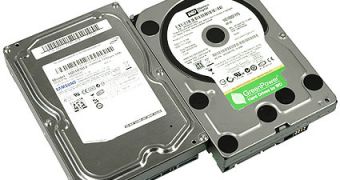The storage industry has undoubtedly undergone a fascinating evolution this year. We have seen the 250 GB notebook hard drive hit the shelves, as well as we have witnessed the first 3.5'' one terabyte hard disk drive. Most of all, the new technology is already mass-produced, with affordable prices for the consumer market. Until now, Hitachi, Seagate and Western Digital have managed to carry capacity above 1 TB. It is now time for Samsung to join the four aces club.
The first to surpass the gigabyte barrier was Hitachi GST with their Deskstar 7K1000. The disk used five platters storing 200 GB each, but as the number of mobile parts increased, so did power consumption and noise levels.
The next to penetrate the terbayte market was Western Digital's Caviar Green Power (GP), that compressed one terabyte on four platters only. Although the disc spins at 5400 RPM, Western Digital compensates the rotational handicap with a more compact design.
Seagate came the third into the terabyte-disc producing elite, but it is worth the waiting, because Seagate's Barracuda 7200.11 is the fastest 3.5" SATA drive on the market. The disc also uses four platters for 1TB of storage, but thanks to the full speed 7,200 RPM spindle, the drive is able to deliver a transfer rate of 100 MB/s.
Samsung has announced their entry in the one-terabyte disk manufacturers elite. Unlike their predecessors, Samsung has approached the terabyte threshold using only three platters, which makes it not only faster than the competition's, but also more economical in terms of absorbed power. Samsung can also speculate new opportunities by delivering single-platter hard drives up to 320 GB with a minimal investment in materials and production costs. The other manufacturers are still nailed down by the maximum 250 GB storage capacity per platter.
Unfortunately, Samsung's architecture does not support upgrades. It would have been logical for Samsung to add a fourth platter get a smashing 1.35 TB hard drive, but unfortunately, this is not possible. While other manufacturers are using 50-millimeter thick platters, Samsung has adopted the 68-millimeter format that increases resistance against vibrations. A fourth platter merely would not fit the hard disk case.

 14 DAY TRIAL //
14 DAY TRIAL //